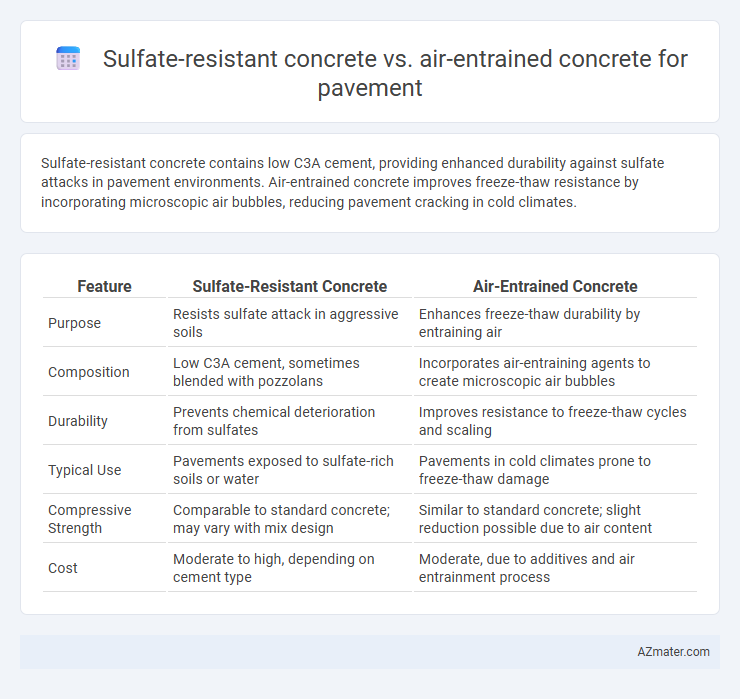Sulfate-resistant concrete contains low C3A cement, providing enhanced durability against sulfate attacks in pavement environments. Air-entrained concrete improves freeze-thaw resistance by incorporating microscopic air bubbles, reducing pavement cracking in cold climates.
Table of Comparison
| Feature | Sulfate-Resistant Concrete | Air-Entrained Concrete |
|---|---|---|
| Purpose | Resists sulfate attack in aggressive soils | Enhances freeze-thaw durability by entraining air |
| Composition | Low C3A cement, sometimes blended with pozzolans | Incorporates air-entraining agents to create microscopic air bubbles |
| Durability | Prevents chemical deterioration from sulfates | Improves resistance to freeze-thaw cycles and scaling |
| Typical Use | Pavements exposed to sulfate-rich soils or water | Pavements in cold climates prone to freeze-thaw damage |
| Compressive Strength | Comparable to standard concrete; may vary with mix design | Similar to standard concrete; slight reduction possible due to air content |
| Cost | Moderate to high, depending on cement type | Moderate, due to additives and air entrainment process |
Introduction to Pavement Concrete Types
Sulfate-resistant concrete is formulated with low C3A content in cement to withstand aggressive sulfate environments, enhancing durability in roads exposed to sulfate-rich soils or groundwater. Air-entrained concrete incorporates microscopic air bubbles to improve freeze-thaw resistance, making it ideal for pavements in cold climates with frequent temperature fluctuations. Selecting the appropriate pavement concrete type depends on environmental conditions, emphasizing sulfate resistance for chemical attack and air entrainment for freeze-thaw durability.
Overview of Sulfate-Resistant Concrete
Sulfate-resistant concrete is specifically formulated with low tricalcium aluminate content to withstand aggressive sulfate attack in soil and groundwater, making it ideal for pavements exposed to sulfate-rich environments. Its enhanced durability prevents chemical deterioration, reducing maintenance costs and extending pavement lifespan. Compared to air-entrained concrete, which primarily improves freeze-thaw resistance, sulfate-resistant concrete addresses chemical resilience critical for stable pavement performance in sulfate-laden conditions.
Fundamentals of Air-Entrained Concrete
Air-entrained concrete incorporates microscopic air bubbles that enhance resistance to freeze-thaw cycles in pavement, improving durability and reducing surface scaling. These entrained air voids create space for water expansion during freezing, preventing internal pressure buildup and cracking. Sulfate-resistant concrete, on the other hand, is formulated to withstand chemical attack from sulfates, but air-entrained concrete specifically targets freeze-thaw resilience critical for pavement performance in cold climates.
Key Differences in Chemical Composition
Sulfate-resistant concrete contains low tricalcium aluminate (C3A) content, typically less than 5%, to reduce chemical reactions with sulfate ions, enhancing durability in sulfate-rich environments. Air-entrained concrete incorporates microscopic air bubbles created by air-entraining agents, which improve freeze-thaw resistance but do not affect the chemical composition related to sulfate attack. The key chemical distinction lies in Sulfate-resistant concrete's modified cement chemistry to prevent sulfate-induced expansion, whereas Air-entrained concrete focuses on physical air void structure for mechanical resilience.
Durability Performance: Sulfate Attack vs. Freeze-Thaw Resistance
Sulfate-resistant concrete is specifically formulated to withstand chemical attacks from sulfate ions, significantly enhancing durability in environments with high sulfate concentrations such as sulfate-rich soils or groundwater. In contrast, air-entrained concrete improves freeze-thaw resistance by incorporating tiny air bubbles that accommodate water expansion during freezing, preventing internal cracking and spalling in cold climates. Selecting between these concretes depends on the predominant exposure risk: sulfate-resistant concrete excels in sulfate attack scenarios, while air-entrained concrete ensures superior durability against freeze-thaw cycles in pavement structures.
Construction Applications and Suitability
Sulfate-resistant concrete offers enhanced durability in pavements exposed to sulfate-rich soils or groundwater, preventing chemical degradation and ensuring long-term structural integrity. Air-entrained concrete improves freeze-thaw resistance by incorporating microscopic air bubbles, making it ideal for pavements in cold climates with frequent temperature fluctuations. Selection between sulfate-resistant and air-entrained concrete depends on environmental conditions such as soil sulfate concentration and exposure to freezing cycles in pavement construction.
Strength and Longevity Comparisons
Sulfate-resistant concrete exhibits enhanced durability and strength in sulfate-rich environments, making it ideal for pavement exposed to aggressive soils or groundwater, with compressive strengths typically ranging from 30 to 50 MPa. Air-entrained concrete improves freeze-thaw resistance by incorporating microscopic air bubbles, significantly enhancing longevity under cyclic temperature conditions but may have slightly reduced compressive strength, usually between 25 and 40 MPa. Choosing between the two depends on environmental exposure; sulfate-resistant concrete is superior for chemical durability, while air-entrained concrete ensures better performance against freeze-thaw damage, impacting overall pavement service life.
Maintenance and Lifecycle Considerations
Sulfate-resistant concrete offers enhanced durability in sulfate-rich soils by minimizing chemical attack, thereby reducing maintenance frequency and extending pavement lifecycle, especially in aggressive environments. Air-entrained concrete provides superior freeze-thaw resistance through microscopic air bubbles that mitigate cracking, decreasing surface deterioration and repair needs in colder climates. Selecting the appropriate concrete depends on environmental exposure and maintenance capabilities, with sulfate-resistant concrete favored for chemical resilience and air-entrained concrete optimized for freeze-thaw durability.
Cost Analysis and Economic Impact
Sulfate-resistant concrete typically incurs higher initial costs due to specialized cement materials designed to withstand sulfate attack in aggressive soil conditions, resulting in lower maintenance expenses over the pavement's lifespan. Air-entrained concrete offers cost benefits by improving freeze-thaw durability, reducing repair needs in cold climates while maintaining competitive upfront pricing. Economic impact assessment favors sulfate-resistant concrete for long-term projects in sulfate-rich environments, whereas air-entrained concrete provides cost-effective durability for pavements exposed primarily to cyclic freezing and thawing.
Choosing the Right Concrete for Pavement Projects
Sulfate-resistant concrete offers superior durability in environments with high sulfate exposure, preventing chemical attack and ensuring long-term pavement integrity. Air-entrained concrete enhances freeze-thaw resistance by incorporating microscopic air bubbles that reduce internal stress during temperature fluctuations. Selecting between sulfate-resistant and air-entrained concrete depends on specific site conditions, such as soil sulfate levels and climate, to optimize pavement lifespan and performance.

Infographic: Sulfate-resistant concrete vs Air-entrained concrete for Pavement
 azmater.com
azmater.com